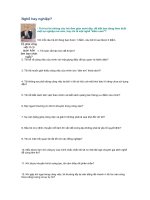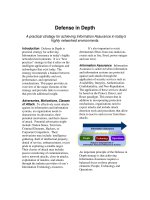Tài liệu Focusing on Customers docx
Bạn đang xem bản rút gọn của tài liệu. Xem và tải ngay bản đầy đủ của tài liệu tại đây (917.71 KB, 35 trang )
1
Chapter 4
Focusing on
Customers
Key Idea
To create satisfied customers, the
organization needs to identify customers’
needs, design the production and service
systems to meet those needs, and
measure the results as the basis for
improvement.
3
Importance of Customer
Satisfaction and Loyalty
•
“Satisfaction is an attitude; loyalty is a behavior”
•
Loyal customers spend more, are willing to pay
higher prices, refer new clients, and are less
costly to do business with.
•
It costs five times more to find a new customer
than to keep an existing one happy.
•
A firm cannot create loyal customers without first
creating satisfied customers.
Key Idea
Customer wants and needs drive
competitive advantage, and statistics
show that growth in market share is
strongly correlated with customer
satisfaction.
5
American Customer Satisfaction
Index
•
Measures customer satisfaction at national level
•
Introduced in 1994 by University of Michigan and
American Society for Quality
•
Continual decline in index from 1994 through
1998 with a small improvement into 2000
suggests that quality improvements have not
kept pace with consumer expectations
ACSI Model of Customer
Satisfaction
Perceived
quality
Customer
complaints
Perceived
value
Customer
satisfaction
Customer
expectations
Customer
loyalty
Key Idea
The econometric model used to produce
ACSI links customer satisfaction to its
determinants: customer expectations,
perceived quality, and perceived value.
Customer satisfaction, in turn, is linked to
customer loyalty, which has an impact on
profitability.
8
Customer-Driven Quality Cycle
measurement and feedback
Customer needs and expectations
(expected quality)
Identification of customer needs
Translation into product/service specifications
(design quality)
Output (actual quality)
Customer perceptions (perceived quality)
PERCEIVED QUALITY is a comparison of ACTUAL
QUALITY to EXPECTED QUALITY
Key Idea
Many organizations still focus more on
processes and products from an internal
perspective, rather than taking the
perspective of the external customer.
Leading Practices (1 of 2)
•
Define and segment key customer
groups and markets
•
Understand the voice of the customer
(VOC)
•
Understand linkages between VOC and
design, production, and delivery
Leading Practices (2 of 2)
•
Build relationships through commitments,
provide accessibility to people and
information, set service standards, and
follow-up on transactions
•
Effective complaint management processes
•
Measure customer satisfaction for
improvement
Key Customer Groups
•
Organization level
–
consumers
–
external customers
–
employees
–
society
•
Process level
–
internal customer units or groups
•
Performer level
–
individual internal customers
Identifying Internal Customers
•
What products or services are produced?
•
Who uses these products and services?
•
Who do employees call, write to, or answer
questions for?
•
Who supplies inputs to the process?
14
AT&T Customer-Supplier Model
Requirements
and feedback
Requirements
and feedback
Your
Suppliers
Your
Processes
Your
Customers
Inputs Outputs
Key Idea
The natural customer-supplier linkages
among individuals, departments, and
functions build up the “chain of
customers” throughout an organization
that connect every individual and function
to the external customers and
consumers, thus characterizing the
organization’s value chain.
Customer Segmentation
•
Demographics
•
Geography
•
Volumes
•
Profit potential
Key Idea
Segmentation allows a company to
prioritize customer groups, for instance
by considering for each group the
benefits of satisfying their requirements
and the consequences of failing to satisfy
their requirements.
Key Dimensions of Quality
•
Performance – primary operating characteristics
•
Features – “bells and whistles”
•
Reliability – probability of operating for specific
time and conditions of use
•
Conformance – degree to which characteristics
match standards
•
Durability - amount of use before deterioration or
replacement
•
Serviceability – speed, courtesy, and
competence of repair
•
Aesthetics – look, feel, sound, taste, smell
19
Key Dimensions of Service
Quality
•
Reliability – ability to provide what was
promised
•
Assurance – knowledge and courtesy of
employees and ability to convey trust
•
Tangibles – physical facilities and
appearance of personnel
•
Empathy – degree of caring and individual
attention
•
Responsiveness – willingness to help
customers and provide prompt service
20
Kano Model of Customer Needs
•
Dissatisfiers: expected requirements
•
Satisfiers: expressed requirements
•
Exciters/delighters: unexpected
features
-> key idea :As customers become
familiar with them, exciters/delighters
become satisfiers over time. Eventually,
satisfiers become dissatisfiers.
21
Customer Listening Posts
•
Comment cards and formal surveys
•
Focus groups
•
Direct customer contact
•
Field intelligence
•
Complaint analysis
•
Internet monitoring
Key Idea
Companies use a variety of methods, or
“listening posts,” to collect information
about customer needs and expectations,
their importance, and customer satisfaction
with the company’s performance on these
measures.
Moments of Truth
•
Every instance in which a customer comes in
contact with an employee of the company.
•
Example (airline)
–
Making a reservation
–
Purchasing tickets
–
Checking baggage
–
Boarding a flight
–
Ordering a beverage
–
Requests a magazine
–
Deplanes
–
Picks up baggage
Key Idea
An organization builds customer loyalty
by developing trust, communicating with
customers, and effectively managing the
interactions and relationships with
customers through approaches and its
people. Companies must carefully select
customer contact employees, train them
well, and empower them to meet and
exceed customer expectations.
Customer Relationship
Management
•
Accessibility and commitments
•
Selecting and developing customer
contact employees
•
Relevant customer contact requirements
•
Effective complaint management
•
Strategic partnerships and alliances
•
Exploiting CRM technology









